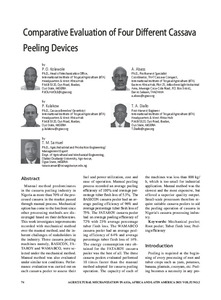| dc.contributor.author | Kolawole, P. |
| dc.contributor.author | Kulakow, P. |
| dc.contributor.author | Samuel, T.M. |
| dc.contributor.author | Abass, A. |
| dc.contributor.author | Diallo, T.A. |
| dc.date.accessioned | 2021-12-21T09:37:04Z |
| dc.date.available | 2021-12-21T09:37:04Z |
| dc.date.issued | 2021 |
| dc.identifier.citation | Kolawole, P., Kulakow, P., Samuel, T.M., Abass, A. & Diallo, T.A. (2021). Comparative evaluation of four different cassava peeling devices. Agricultural Mechanization in Asia, 52(2), 74-81. |
| dc.identifier.issn | 0084-5841 |
| dc.identifier.uri | https://hdl.handle.net/20.500.12478/7298 |
| dc.description.abstract | Manual method predominates in the cassava peeling industry in Nigeria as more than 70% of the processed cassava in the market passed through manual process. Mechanical option has come to the forefront since other processing methods are discouraged based on their deficiencies. This work investigates improvements recorded with mechanical method over the manual method, and the inherent challenges of stakeholders in the industry. Three cassava peeling machines namely, BASICON, FATAROY and WAMABCO, were selected under the mechanical method. Manual method was also evaluated under similar test conditions. Performance evaluation was carried out on each cassava peeler to assess their fuel and power utilization, cost and ease of operation. Manual peeling process recorded an average peeling efficiency of 100% and average percentage tuber flesh loss of 5.5%. The BASICON cassava peeler had an average peeling efficiency of 96% and average percentage tuber flesh loss of 75%. The FATAROY cassava peeler had an average peeling efficiency of 72% with 23% average percentage tuber flesh loss. The WAMABCO cassava peeler had an average peeling efficiency of 64% and average percentage tuber flesh loss of 14%. The energy consumption rate obtained for the FATAROY cassava peeler was the best of all. The three cassava peelers evaluated performed 10 times faster than the manual method adopted for cassava peeling operation. The capacity of each of the machines was less than 800 kg/h, which is too small for industrial application. Manual method was the slowest and the most expensive, but offered a superior quality output. Small-scale processors therefore require suitable cassava peelers to aid the peeling operation of cassava in Nigeria’s cassava processing industry. |
| dc.format.extent | 74-81 |
| dc.language.iso | en |
| dc.subject | Cassava |
| dc.subject | Mechanical Peeling |
| dc.subject | Peeling |
| dc.subject | Processing |
| dc.subject | Nigeria |
| dc.title | Comparative evaluation of four different cassava peeling devices |
| dc.type | Journal Article |
| cg.contributor.crp | Agriculture for Nutrition and Health |
| cg.contributor.crp | Roots, Tubers and Bananas |
| cg.contributor.affiliation | International Institute of Tropical Agriculture |
| cg.contributor.affiliation | Olabisi Onabanjo University |
| cg.coverage.region | Africa |
| cg.coverage.region | West Africa |
| cg.coverage.country | Nigeria |
| cg.coverage.hub | Eastern Africa Hub |
| cg.coverage.hub | Headquarters and Western Africa Hub |
| cg.researchtheme | Biotech and Plant Breeding |
| cg.researchtheme | Social Science and Agribusiness |
| cg.identifier.bibtexciteid | KOLAWOLE:2021 |
| cg.isijournal | ISI Journal |
| cg.authorship.types | CGIAR and developing country institute |
| cg.iitasubject | Agribusiness |
| cg.iitasubject | Agronomy |
| cg.iitasubject | Cassava |
| cg.iitasubject | Food Security |
| cg.iitasubject | Plant Breeding |
| cg.iitasubject | Plant Production |
| cg.iitasubject | Socioeconomy |
| cg.iitasubject | Value Chains |
| cg.journal | Agricultural Mechanization in Asia, Africa and Latin America |
| cg.accessibilitystatus | Limited Access |
| cg.reviewstatus | Peer Review |
| cg.usagerightslicense | Copyrighted; all rights reserved |
| cg.targetaudience | Scientists |
| cg.iitaauthor.identifier | Peter Kulakow: 0000-0002-7574-2645 |
| cg.iitaauthor.identifier | Adebayo Abass: 0000-0003-1376-3608 |
| cg.futureupdate.required | No |
| cg.identifier.issue | 2 |
| cg.identifier.volume | 52 |
| cg.contributor.acknowledgements | The authors would like to thankfully acknowledge the support of CGIAR - IITA and RTB for this research. |

